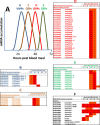Integrated proteomic and transcriptomic analysis of the Aedes aegypti eggshell
- PMID: 24707823
- PMCID: PMC4234484
- DOI: 10.1186/1471-213X-14-15
Integrated proteomic and transcriptomic analysis of the Aedes aegypti eggshell
Abstract
Background: Mosquito eggshells show remarkable diversity in physical properties and structure consistent with adaptations to the wide variety of environments exploited by these insects. We applied proteomic, transcriptomic, and hybridization in situ techniques to identify gene products and pathways that participate in the assembly of the Aedes aegypti eggshell. Aedes aegypti population density is low during cold and dry seasons and increases immediately after rainfall. The survival of embryos through unfavorable periods is a key factor in the persistence of their populations. The work described here supports integrated vector control approaches that target eggshell formation and result in Ae. aegypti drought-intolerant phenotypes for public health initiatives directed to reduce mosquito-borne diseases.
Results: A total of 130 proteins were identified from the combined mass spectrometric analyses of eggshell preparations.
Conclusions: Classification of proteins according to their known and putative functions revealed the complexity of the eggshell structure. Three novel Ae. aegypti vitelline membrane proteins were discovered. Odorant-binding and cysteine-rich proteins that may be structural components of the eggshell were identified. Enzymes with peroxidase, laccase and phenoloxidase activities also were identified, and their likely involvements in cross-linking reactions that stabilize the eggshell structure are discussed.
Figures





Similar articles
-
Identification of Mosquito Eggshell Proteins from Aedes aegypti by Liquid Chromatography with Tandem Mass Spectrometry (LC-MS/MS) Proteomic Analysis.Cold Spring Harb Protoc. 2024 Oct 1;2024(10):pdb.prot108227. doi: 10.1101/pdb.prot108227. Cold Spring Harb Protoc. 2024. PMID: 38190636
-
Proteomics reveals novel components of the Anopheles gambiae eggshell.J Insect Physiol. 2010 Oct;56(10):1414-9. doi: 10.1016/j.jinsphys.2010.04.013. Epub 2010 May 5. J Insect Physiol. 2010. PMID: 20433845 Free PMC article.
-
Characterization of essential eggshell proteins from Aedes aegypti mosquitoes.BMC Biol. 2023 Oct 13;21(1):214. doi: 10.1186/s12915-023-01721-z. BMC Biol. 2023. PMID: 37833714 Free PMC article.
-
Proteomics informed by transcriptomics for characterising active transposable elements and genome annotation in Aedes aegypti.BMC Genomics. 2017 Jan 19;18(1):101. doi: 10.1186/s12864-016-3432-5. BMC Genomics. 2017. PMID: 28103802 Free PMC article.
-
Embryonic desiccation resistance in Aedes aegypti: presumptive role of the chitinized serosal cuticle.BMC Dev Biol. 2008 Sep 13;8:82. doi: 10.1186/1471-213X-8-82. BMC Dev Biol. 2008. PMID: 18789161 Free PMC article.
Cited by
-
Antennal and Abdominal Transcriptomes Reveal Chemosensory Genes in the Asian Citrus Psyllid, Diaphorina citri.PLoS One. 2016 Jul 21;11(7):e0159372. doi: 10.1371/journal.pone.0159372. eCollection 2016. PLoS One. 2016. PMID: 27441376 Free PMC article.
-
Candidate Chemosensory Genes Identified in the Adult Antennae of Sympiezomias velatus and Binding Property of Odorant-Binding Protein 15.Front Physiol. 2022 May 31;13:907667. doi: 10.3389/fphys.2022.907667. eCollection 2022. Front Physiol. 2022. PMID: 35711318 Free PMC article.
-
Insect prophenoloxidase: the view beyond immunity.Front Physiol. 2014 Jul 11;5:252. doi: 10.3389/fphys.2014.00252. eCollection 2014. Front Physiol. 2014. PMID: 25071597 Free PMC article. Review.
-
Candidate odorant binding proteins and chemosensory proteins in the larval chemosensory tissues of two closely related noctuidae moths, Helicoverpa armigera and H. assulta.PLoS One. 2017 Jun 8;12(6):e0179243. doi: 10.1371/journal.pone.0179243. eCollection 2017. PLoS One. 2017. PMID: 28594956 Free PMC article.
-
Functional Diversification, Redundancy, and Epistasis among Paralogs of the Drosophila melanogaster Obp50a-d Gene Cluster.Mol Biol Evol. 2021 May 4;38(5):2030-2044. doi: 10.1093/molbev/msab004. Mol Biol Evol. 2021. PMID: 33560417 Free PMC article.
References
-
- Margaritis LH. In: Comprehensive Insect Physiology, Biochemistry and Pharmacology. Volume I Embryogenesis and Reproduction. Kerkut GA, Gilbert LI, editor. Oxford: Pergamon Press; 1985. Structure And Physiology Of The Eggshell; pp. 153–230.
-
- Waring GL. Morphogenesis of the eggshell in Drosophila. Int Rev Cytol. 2000;198:67–108. - PubMed
-
- Suman DS, Shrivastava AR, Parashar BD, Pant SC, Agrawal OP, Prakash S. Variation in morphology and morphometrics of eggs of Culex quinquefasciatus mosquitoes from different ecological regions of India. J Vector Ecol. 2009;34:191–199. - PubMed
Publication types
MeSH terms
Substances
Grants and funding
LinkOut - more resources
Full Text Sources
Other Literature Sources

